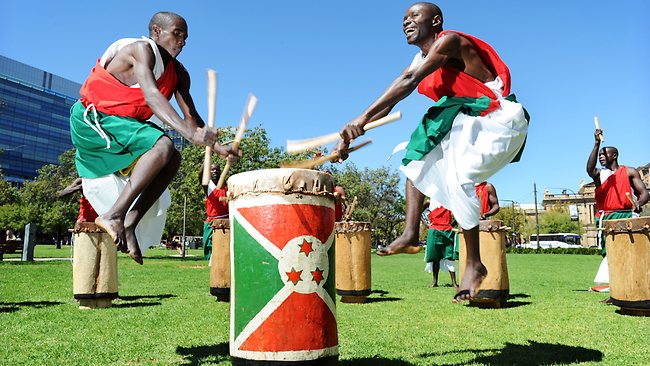
Burundi
Rhythmic Burundi
As drumbeats of karyenda play through the streets of Bujumbura – you’ll find the music follow you through your journey of Burundi. The history of civil war has built a nation of resilient people. Burundian’s use the sounds of music to connect, build and move forward. Let Burundi tell you it’s story through its music.
Burundian cuisine is built mainly on African tastes but does somewhat incorporate French influences. Expect beans, cassava and plantains to make regular appearances. Vegetables and fruits are popular, but meat is not commonly consumed. You can find goat, sheep and freshwater fish on many menus. Try Botanika in the capital, offering French, Moroccan and African dishes. It sits in a courtyard decorated in bougainvillea flowers scattered around. Kibiko Grill is also a great dining choice. Grilled brochettes and fish await you.

http://www.discoveringafricanetwork.com/tasty-food-from-burundi.html (Burundian food)
Watch life around Lake Tanganyika as you smile quietly to yourself. An artificial beach of sorts, Lake Tanganyika is a source of life to Bujumbura. And the hive of activity is Saga Beach. Warm waters, golden sands and lively people make this a beautiful spot to relax as the sun sets on Burundi. There are several restaurants, bars and resorts on the stretch of Saga Beach. Sip on some coconut water, eat fried plantain and watch as fisherman make their way back to land after day on the lake. Spend an afternoon here and watch Saga Beach come alive. Or watch the sunrise if crowds aren’t your thing. Either way, pack a towel and take a swim – the water is perfect.

http://www.enjoyburundi.info/where-to-stay/bujumbura/keza-saga-plage-hotel/ (Saga Beach)
Tracking troupes of Colobus monkeys and chimpanzees in Parc National de la Kibira is an exhilarating experience. The large rainforest flows into the Nyungwe National Park in Rwanda and you definetly won’t be able to view the park in under a day. The park isn’t as modernised as other parks in the Central African region and it is advisable to stay toward the known tracks. But if you are rather adventurous, organise a guided tour with a tour agency in the area. Tour guides will know the park well enough to know where wildlife can generally be found.

http://fr.africatime.com/burundi/articles/burundi-les-services-ecosystemiques-du-parc-national-de-la-kibira-restent-non-valorises (Parc National de la Kibira)
Dress in Burundi is moving away for more traditional garments in recent years. However, you can still see women wearing wrap cloths, called pagnes as skirts or dresses. Most often though women do wear pagnes over dress, skirts or blouses. Women also wear headwraps. Men can be seen wearing trousers and shirts, on a day to day basis. Due to the different ethnic tribes, attire at religious or traditional functions differ. It is also a predominantly Muslim country, which is why attire is more conservative.

Burundian women
After years of civil war and genocide, culture has not been as well preserved in Burundi. Karyenda drums still beat to this day, but much as been lost to the county’s turbulent past. The Burundi government has encouraged ethnic cultural promotional and more than that – but the art and culture industry in Burundi is staggering. You can find drums, statues, wooden masks and bamboo figurines, but there aren’t many unique art pieces in the country to immerse yourself into Burundian culture. Whichever pieces you find enticing in the stalls strewn across Bujumbura, do buy a drum to take back as a reminder of the sweet sounds of Burundian people.

https://face2faceafrica.com/article/drummers-of-burundi (Drummers)
Though the political tension in the country is still a negative factor, Burundi is a country with a promising tourism industry. There is much Burundi can offer you, but its people are the most important. Burundians and their stories will make your journey worthwhile. Take a chance and find yourself dancing to the beats of Karyenda drums. You may find yourself pleasantly surprised.
